The majority of caterpillars have twelve eyes, six on either side of their head. A few species have between ten and fourteen eyes instead. These species are largely more primitive forms, which also have other features that mark them out from other moths and butterflies.
Contents
Do caterpillars have eyes?

We tend to think of insects as having compound eyes, like that of a fly. These compound eyes are actually a group of smaller eyes called ommatidia. It’s this type of eye that moths and butterflies have. Moths also have an additional pair of simple eyes (ocelli) that help them sense light. Caterpillars, however, do not have compound eyes, instead of having a number of stemmata, a type of simple eye.
These eyes are located below the antenna in a rough circle. It is thought that a caterpillar’s sight is relatively simple, picking out light and dark, and in some cases other things like polarised light.
| Caterpillar Family | Number of Eyes |
|---|---|
| Pieridae (Whites and Yellows) | 6 |
| Nymphalidae (Brush-footed Butterflies) | 6 or 8 |
| Saturniidae (Silkmoths) | 6 or 8 |
| Noctuidae (Owlet Moths) | 6 |
| Geometridae (Geometer Moths) | 6 or 8 |
Also read: Does a Caterpillar Have Legs? (Prolegs vs. True Legs)
The twelve-eyed caterpillars
The majority of caterpillars have the same number of eyes; this is six on either side of their head. These eyes are roughly all the same size, though some species do have different types of lenses in different stemmata.
Peacock butterfly
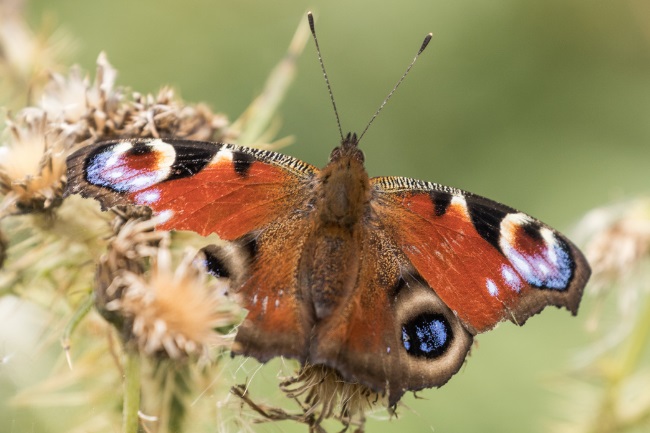
The peacock butterfly is a highly distinctive species as an adult, the dark red wings featuring bright blue eyespots. The caterpillar is almost as recognisable, with its dark black colour punctuated by a constellation of white dots and its dangerous-looking black spikes, making it look somewhat punk. It’s key food species is the nettle, where you can find it munching away happily in large groups.
Monarch butterfly
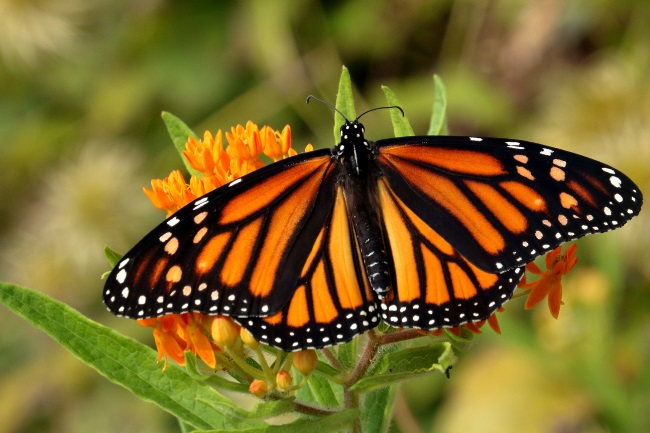
The monarch butterfly is one of the world’s most famous migrators. The young caterpillars build up their strength by feeding on milkweeds. Their beautiful pale blue and green stripes are decorated with elegant black stripes, helping them camouflage amongst shadowy foliage. The bright colours of the adults warn predators of their toxic innards, so as to keep them at bay.
Also read: What Caterpillars turn into Monarch Butterflies? (A List)
Large emerald moth
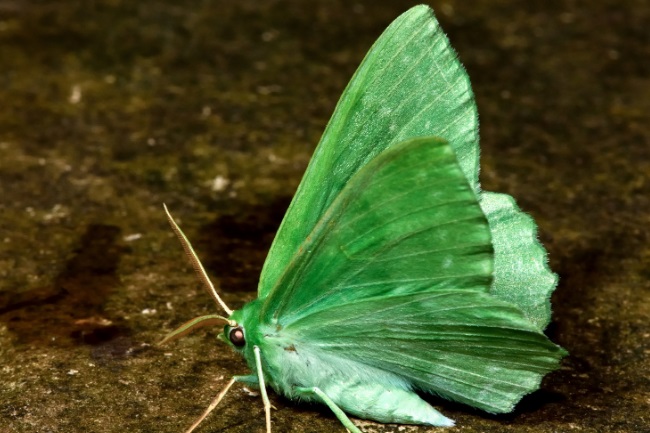
The large emerald is a beautiful looking moth; pale green, with scalloped edges. Its caterpillars are one of the variety often described as loopers, who have no prolegs in the centre of their bodies, meaning they need to bring their back legs up to their front legs in order to inch their way along a branch. They feed on a variety of species, such as downy birch and alder.
Also read: Moths Eating and Drinking Habits Explained
Kauri moths
There are only two species of Kauri moths known in the world, one found in Fiji and the other in Queensland. The larvae are adapted to bore into the seeds of species of Kauri trees. Agathiphaga queenslandensis was recently rediscovered in South Queensland after a forty-year absence. The Fiji Kauri moth Agathiphaga vitiensis feeds on the Pacific Kauri. The adult moths aren’t too exciting, small brown diurnal moths; however, what makes the larvae unusual is that they have seven stemmata on each side of their heads.
Micropterygidae
The family micropterygidae is an archaic group of small moths. Some entomologists separate them from other Lepidoptera (butterflies and moths) as they have many distinctive features. Firstly the adults keep hold of their mandibles, which are usually lost after they pupate; this gives the group their name.
Another primitive feature is that they have five stemmata on each side of their heads rather than six. Unlike other caterpillars, whose eyes are spaced out, these tend to be roughly grouped. Within most species of caterpillars, the stemmata are approximately the same size, whereas, in specific genera of micropterygidae, one or more stemmata may be a slightly different size.
Unlike the Kauri moths, which aren’t visually very exciting, the 120 species within the various genera of micropterygidae are excitingly coloured in metallic purples, golds and greens.
Also read: Explaining: If Moths Have a Backbone, Exoskeleton, & More
Yellow-barred gold
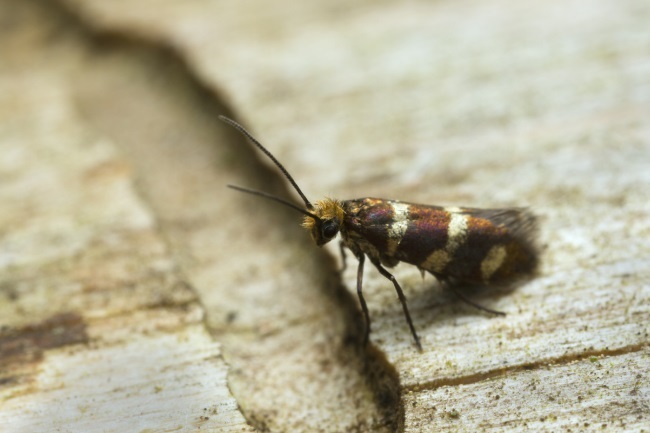
This tiny day-flying moth is rather stunning in its dark reddy brown wings, with their golden stripes and dots. With its functioning mandibles, it can eat the pollen grains of various flowers, particularly sedges. Like many of this group, the caterpillar is unknown but is thought to feed on bilberry.
Also read: Do Bees Eat Pollen? What & How Often do They Actually Eat?
Red barred gold
This is another attractive micro moth, with wavey patterns of gold across a purple background. The adult feeds on the pollen of flowering plants, such as oak and sycamore. Flying throughout May and June, much of its lifecycle is unknown.
Marsh marigold moth
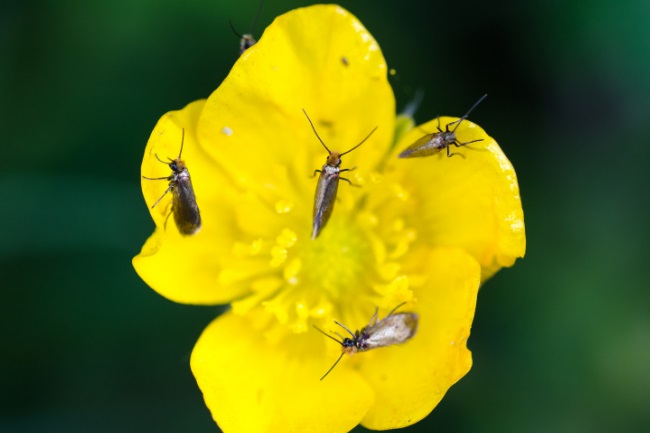
With its bronze wings, this moth may be more plainly garbed than its friends, but it’s still very attractive. It lives in wet areas across Europe and feeds on the pollen of a variety of different species. The caterpillar feeds on plant detritus and sometimes liverworts.
Also read: What do Caterpillars Eat? (Vegan vs. Carnivore Caterpillars)
Leaf-mining moths
Leaf-mining moths spend their caterpillars days burrowing through the plant’s internal workings, safely eating their fill without being discovered. Because of their unusual lifestyle, they are often slightly different from the other caterpillars, including the number of eyes they have.
Very little information exists on which species have fewer or more eyes than the average. However, whenever you see their little pathways marked across the surface of a leaf, you’ll know they are perhaps a little blinder than their cousins.
Also read: Do Butterflies have Eyes? What do They See?
Twelve eyes are better than none
A caterpillar’s ten to fourteen stemmata are the start of what will become their compound eye as an adult. Whereas an adult moth or butterfly needs to be able to react quickly to moving objects, as they flutter their way through the world, caterpillars spend most of their time with their heads down, munching merrily away on their favourite food.
Yet, there are variations between species in how their eyes work and what they can pick up on, perhaps dealing with their different needs. It’s also worth remembering that both caterpillars and their adult forms have an antenna that provide them with a wide variety of sensory information, which they can utilise to ‘see’ their way around their world.

